 | E-mail to Birds Korea |
 | KWBS |
in the Region
 | The Oriental Bird Club |
 | BirdLife International (Asia) |
December
Periods of intense cold alternate with milder spells. In the coldest winters maxima are often below freezing; in milder years (such as 2001 and 2002) maxima often reach 10°C in Seoul: a few lingering autumn migrants can still sometimes be found as well as huge numbers of wintering waterbirds.
A great time for full winter bird tours or a couple of days in the right areas. Saunders's Gulls are widespread, while Relict Gulls also start to appear at a number of sites, especially in cold winters. Scaly-sided Merganser move southward onto unfrozen rivers, while numbers of Baikal Teal remain at their peak - often dispersing southward from Seosan, along with large numbers of Greater White-fronted and Thick-billed Bean Geese with the onset of subzero temperatures. Taiga Beans too can be found in the low thousands at Woopo, Joonam and in the Nakdong in the southeast, the mildest part of the mainland.
Raptors include good numbers of Cinereous Vulture (especially in recent years) and these are often joined by White-tailed and several Steller's Sea Eagles, while cranes (Red-crowned, Hooded, and White-naped), remain at key sites.
Passerines include occasionally abundant Brambling, mixed flocks of Naumann's and Dusky Thrushes and in some winters large numbers of Siberian Accentor. Species such as White's and Pale Thrush, Red-flanked Bluetail and Japanese White-eye also remain in reasonable numbers on Jeju Island and in the far southeast. Highlights in December 2002 included Korea's first Great Black-headed(or Pallas's) Gull in Seoul, Pigeon and Spectacled Guillemots off the east coast, and several Red-throated Thrushes and Chinese Nuthatches in the northwest. Highlights in 2003 included Korea's first Grass Owl - found dead on Heuksan Island.
(The following records are a compilation of our own sightings and records sent in by other observers. As well as being posted on the Birds Korea website(s), selected records are also forwarded to other Korean-language birding websites; records of threatened species are arranged and forwarded to Birdlife International and national authorities when appropriate; flag images and records are passed to bodies responsible for their coordination throughout the flyway; and all records sent to us are used to compile annual reports and to support the evolving understanding of the status of many of Korea’s birds.)
Langenberg, Thomas Langenberg, Johanna Rathgeber-Knan, Armin Schneider) & Nial Moores.
Mangyeung (Saemangeum), Mangyeung Lake, Geum Barrage, Yubu Island, December 31
Some really good birding, with 86 species logged and multiple highlights, on a day of mixed weather, with periods of sunshine and occasionally heavy snow showers and near-freezing temperatures throughout. First well-seen bird of the day was an Upland Buzzard, with a second individual found 10 km west. On the Mangyeung east of Hwapo, excellent views of a feeding male Pallas's Reed Bunting, a calling Japanese Bush Warbler, and a very distant stork sp (either an Oriental or the escaped White Stork from Jeonju Zoo), while in saltmarsh east of Simpo a single flock of at least 260 Buff-bellied Pipit, perhaps the largest flock recorded in Korea to date? At Mangyeung Lake, excellent views of Falcated Duck (c. 100), and good views of a single Baikal Teal and Eastern Great Egret, with 10 probable very distant Swan Goose mixed in with 250 Taiga Bean Geese. At the Geum Barrage, 5 Swan Goose. The shorebird count on Yubu found 910 Eastern Oystercatcher, 648 Grey Plover, 2 Far Eastern and 1555 Eurasian Curlew, 65 Sanderling and 1085 Dunlin. Gulls produced even more interest. 8 Slaty-backed, c. 50+ Taimyr and 80 Saunders's Gull were counted, while outstanding highlight of the day was Korea's first Lesser Black-backed Gull Larus fuscus, with an adult found and photographed at long range (NM), and seen by all of the group. Based on the darkness (blackness) of its upperparts and its incomplete primary moult, it seems likely that this was a nominate fuscus or Baltic Gull. This species, found within the last 3 hours of the last day of the year, appears to have been only the third national first of the year.

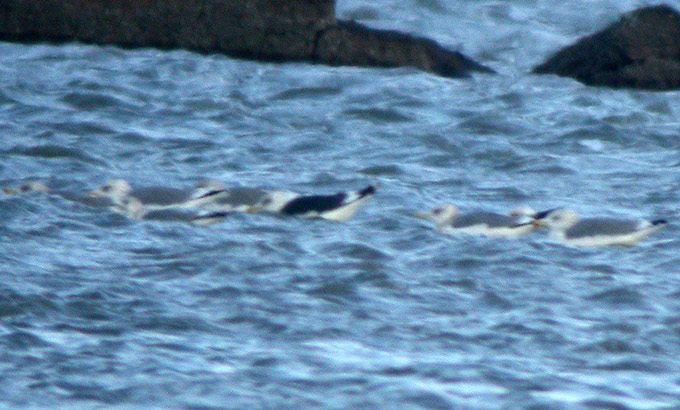
Langenberg, Thomas Langenberg, Johanna Rathgeber-Knan, Armin Schneider) & Nial Moores.
Baeksu and west Hampyeong Bay, December 30
The shorebird count was somewhat hindered by poor tides, strong winds and occasional spells of heavy snow. At Baeksu, Dunlin (370) and Grey Plover (132) were the two most numerous shorebirds, while a single Ruddy Turnstone and 3 Japanese Quail were the highlights. In Hampyeong Bay, new road construction etc. also created access problems, with Dunlin (507) and Grey Plover (161) the two most numerous species.
Langenberg, Thomas Langenberg, Johanna Rathgeber-Knan, Armin Schneider) & Nial Moores.
Gocheonnam, Haenam Hwangsan, Yeongam Ho Aphae Island, December 29
In mild and dull conditions, at Gocheonnam Lake 2 Great Bittern, with one challenging a Northern Harrier (one of 35 + coming out from the roost), single Bluethroat and Eastern Yellow Wagtail, 2 Dusky Warbler, a Lesser White-fronted Goose heard (but not seen) and c. 800 Eurasian Wigeon. Along the coast in Haenam, few shorebirds but 84 Saunders's Gull and excellent views of a Taivana wagtail. Towards Mokpo, an Upland Buzzard, and near the Dinosaur centre, single Whiskered Tern, and a Siberian Accentor heard. At Yeongam Lake (now a massive building site at its western end), a single Red-throated Pipit and a raft of 250,00+ Baikal Teal, while on Aphae (also increasingly modified) very few shorebirds, with most numerous Eurasian Curlew (190) and Kentish Plover (75).
Hwajinpo and surroundings, December 28-30
I arrived in Hwajinpo in the afternoon of the 28th; clear calm weather with good numbers of birds on the ocean but few alcids. Highlights were several hundred Red-breasted Mergansers and good numbers of Black-necked, Red-necked, and Great-crested Grebes, Pacific and Arctic Divers, Goldeneyes, Harlequin Ducks, and Velvet and Black Scoters. Only one group of 8 Ancient Murrelets in evidence, but these were augmented by no less than 3 Long-billed Murrelets.
On the 29th I met T.E. in Aya-jin; his report will suffice.
The 30th before the bus had a Long-billed Murrelet again but no other alcids. One Eurasian Sparrowhawk noted. New small birds were 2 Siberian Accentors, 3 Long-tailed Rosefinches, a Dusky Thrush, a Hawfinch, and about a dozen Bramblings.
Also from the bus to and fro: 2 Dippers, a male Smew, and several Common Buzzards.
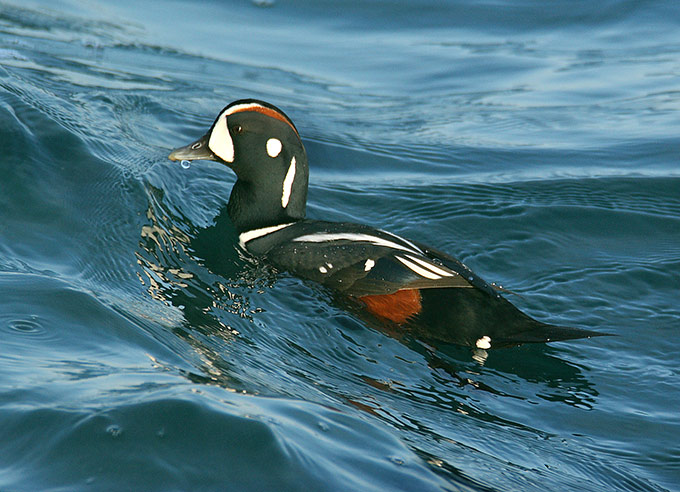

Iajin Port, December 29
Best in the harbour were absurdly close views of a Black Brant, closely associating with a drake Falcated Teal: likewise up to 30 Black-legged Kittiwake lounging on the rocks. Surprisingly common this winter, 14 Glaucous Gull included a pure "flock" of 5 fishing together at sea. 5 Eurasian Wigeon foraging on the rocky foreshore seemed a little out of place, with 3 Sanderling nearby and a Northern Goshawk in coastal trees. Further offshore, 10-15 Ancient Murrelet, both Pacific and Black-throated Loons, a Slavonian and several Black-necked Grebe, 1 Greater Scaup, 7 Harlequin, and at least 3-400 Red-breasted Merganser, with some performing their head-popping and bowing courtship displays.
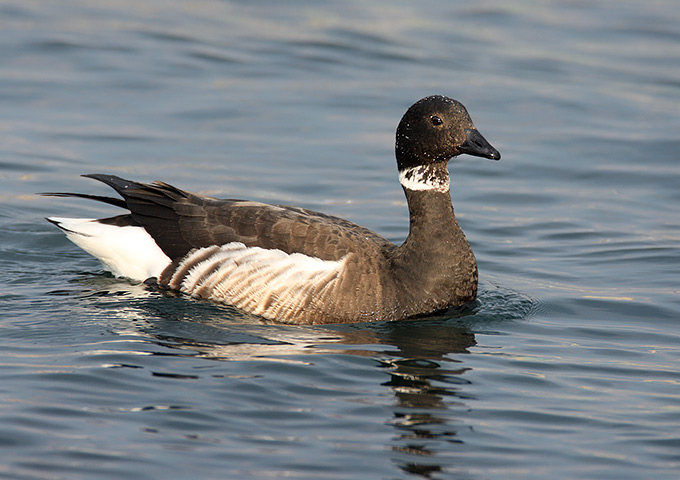

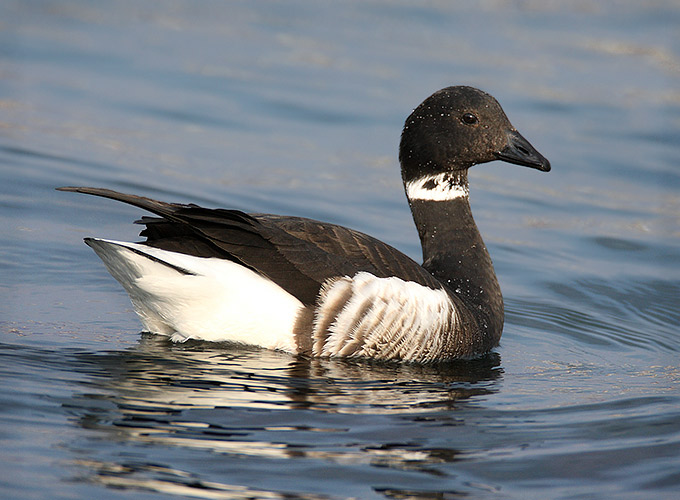

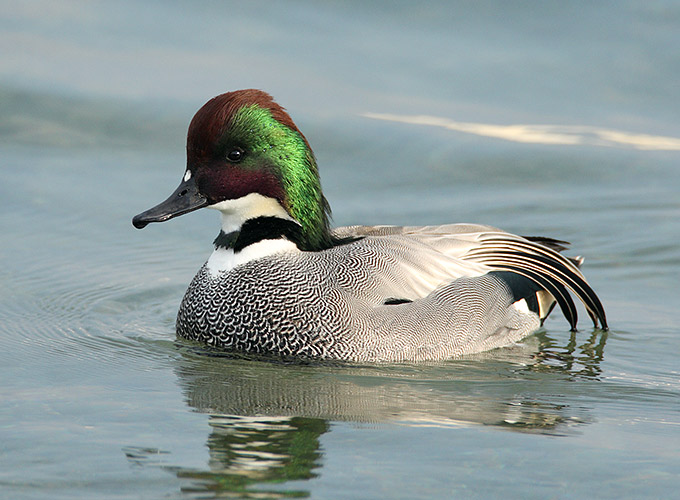

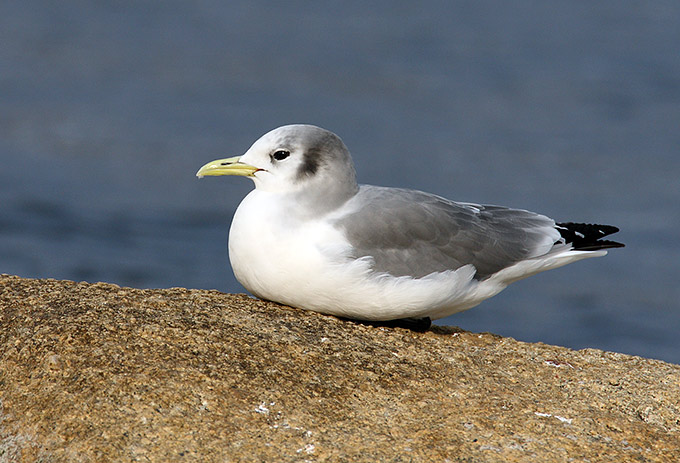
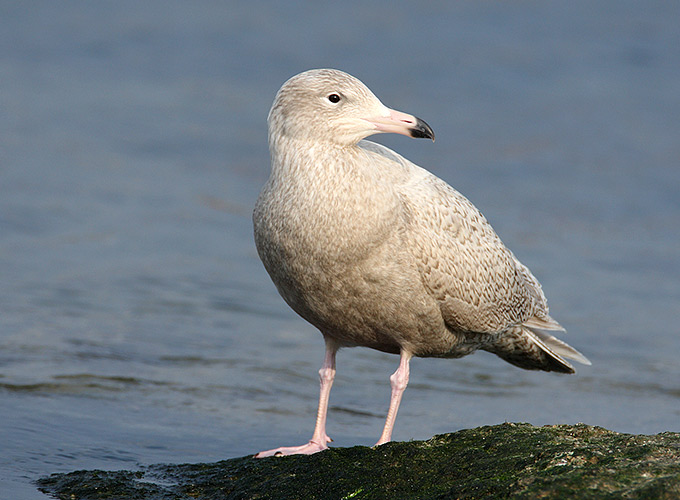
Paldang/Deokso, December 29
It was a gray but quite productive morning along the stretch from Paldang to Deokso. There were approximately 100 Whooper Swan adjacent to Paldang Stn. From the bridge, all the way to Deokso, there were at least 1,000 - 1,500 Common Merganser. Near the 'rapids' there were 70 Coot mixed in with more of the common ducks, such as Mallard and Common Pochard. 1 Stellar's Sea Eagle and 3 Steller's Sea Eagle enjoyed themselves on the farthest stony outcrop. Along the second water station (which is undergoing waterfront construction), I found 6 Goldcrest in a feeding frenzy in some young pine trees. Finished off the morning at Deokso noticing 5 male and 7 female Eurasian Wigeon.
Langenberg, Thomas Langenberg, Johanna Rathgeber-Knan, Armin Schneider) & Nial Moores.
Goheung Bay, Suncheon Bay and Gocheonnam Lake, December 28
With sunny skies and mild temperatures, the search for Siberian Crane ended in failure. Compensation at Goheung Bay was provided by the Oriental Stork (seen well), with the same or a second bird later found 4 km south in rice-fields, apparently two adult Pallas's Gull (both photographed, revealing differences in the head-pattern), 4 Whiskered Tern and 2 Taivana wagtail. At Suncheon Bay, c. 50 Hooded, 1 White-naped and 1 Common Crane, while a further highlight came in the form of a Chinese Grey Shrike. In the last hour of light at Gocheonnam, no Baikal Teal, rather single Eastern Marsh Harrier, Dusky Warbler, Eastern Yellow Wagtail and Bluethroat and at least 7 Lesser White-fronted Geese (4 adults and 3 first winters forming a single group).
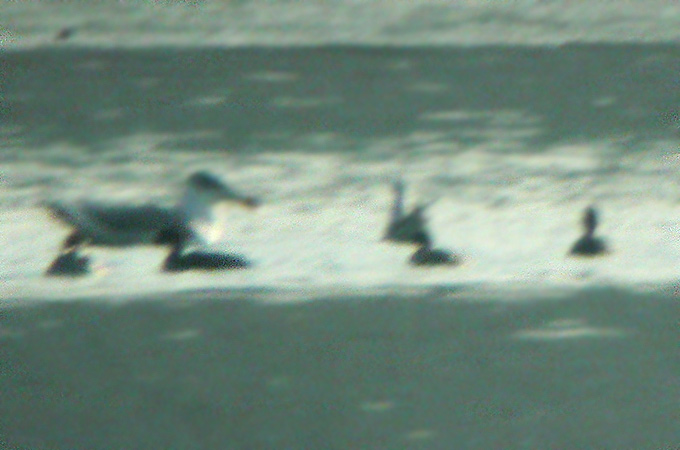
Sokcho/ Susan harbour/ Namdae River, December 28
A thick layer of snow carpets the east coast, accompanied by minus temperatures. At Youngrang lake, Sokcho,2 Smew, 24 Greater Scaup, and single numbers of Goldeneye & Tufted Duck. Later at Susan harbour, 4 Glaucous Gull: further out a mixture of Pelagic and Temminck's Cormorant, with 1 Arctic Diver and 5 Black Scoter. Most unusual a Japanese Lesser Sparrowhawk seen well, which is a scarce winter sighting. Along the swampy lower reaches of the Namdae river at Yang Yang, a Japanese Quail flushed at close range, giving rapid purring wingbeats similar (but quieter) to the nearby Ring-necked Pheasants. Also 2 Northern Lapwing, a Merlin, 30+ Pallas's Bunting (some showing very white rumps), and a Japanese Wagtail. Towards the rivermouth, more Goldeneye, 3 Gadwall and 6 Greater Scaup. At the sandbar, a lone Peregrine, a spectacular roost of 1000+ Common Gull (showing some individual size ranges), and 3 more Glaucous Gull. Five Korean Water Deer were also in this reedy riverside habitat. On the open sea, 22 White-winged Scoter, a Slavonian Grebe, 6 Red-breasted Merganser, a Pacific Loon, and at least 300 Ancient Murrelet moving further offshore.
Ganghwa Do, December 28th
On the Island I encountered a lot of bird activity. Near Onsuri I had really good views of 12 Azure-winged magpie and 5 Chinese Grosbeak. Making my way to Jang Heung Ri, on a utility road leading to two fish ponds, I witnessed 7 Siberian Accentor, 6 Dusky Thrush (naumanni), 1 female Long-Tailed Rosefinch, and 6 Hawfinch. The huge fishpond at Jang Heung Ri was frozen, but that did not stop 400 Ruddy Shelduck from slipping and sliding. I tested my luck also at SunDoRi, only to find 1 Japanese Quail, and 5 Common Buzzard. Note: ThereBis a very large 2 lane highway being built quite rapidly between the mudflats of Jang Heung Ri and Onsuri. This road is parallel to the one currently used. Already there is massive deforestation through the hills. I would imagine an extensive loss of rice fields on either side of the highway.
Langenberg, Thomas Langenberg, Johanna Rathgeber-Knan, Armin Schneider) & Nial Moores.
Airport-Goheung Bay, December 27
A "quick twitch" for the Siberian Crane before colder weather arrives ended with no crane, but rather a distant Oriental Stork and 2 Tundra Swan.
Seosan, December 25
The morning began with 1000+ Rook at Asan bay en route to Seosan, where sadly development has accelerated recently, leaving perhaps 25% of the areas formerly wild ditches and waterways suddenly banked and concreted by the new individual landowners: a significant loss of habitat. Many new farm buildings dot over the area, and plenty of reedbed clearance, bulldozers, traffic, and far fewer birds than 3 years ago. The transition from vast wild place to intensive farming zone is in rapid progress.
Flocks of Greater White-fronted and Tundra Bean Geese are smaller and more dispersed than former years, as new agricultural techniques leave far less grain on the ground for feed.
Most noteworthy for the day, 5 Oriental White Stork, 2 Common Crane (accompanied by 2 more hybrids), 300+ Whooper Swan, probably 2- 400 Great Crested Grebe on both lakes, unusually for here perhaps c.20 Red-breasted Merganser and 34 Hooded Crane.
Otherwise, 35 Eurasian Spoonbill, 1 White-tailed Eagle, small flocks of Azure-winged Magpie, Siskins and Brambling, single numbers of Pallas's Reed Bunting, 2 Siberian Accentor, 2 Eurasian Sparrowhawk, and up to 20 Common Buzzard, 5 or 6 Korean Water Deer, and a handful of Coot only.
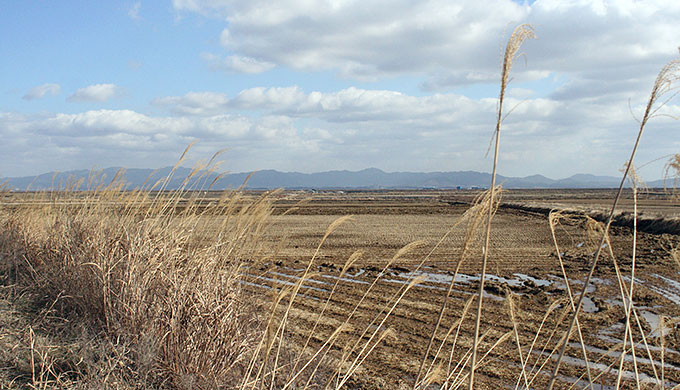
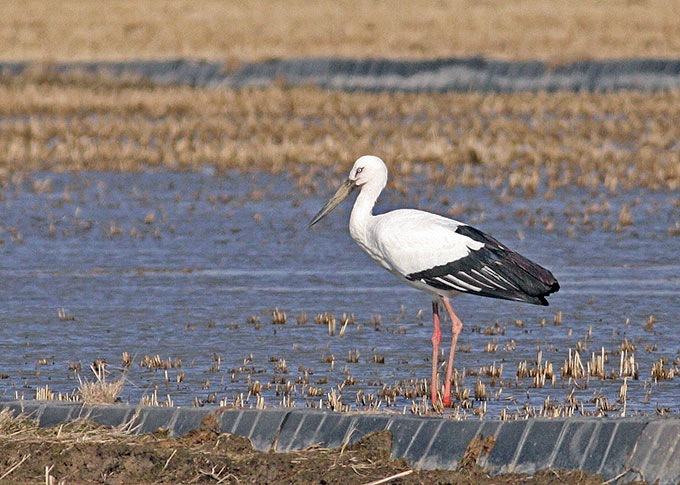

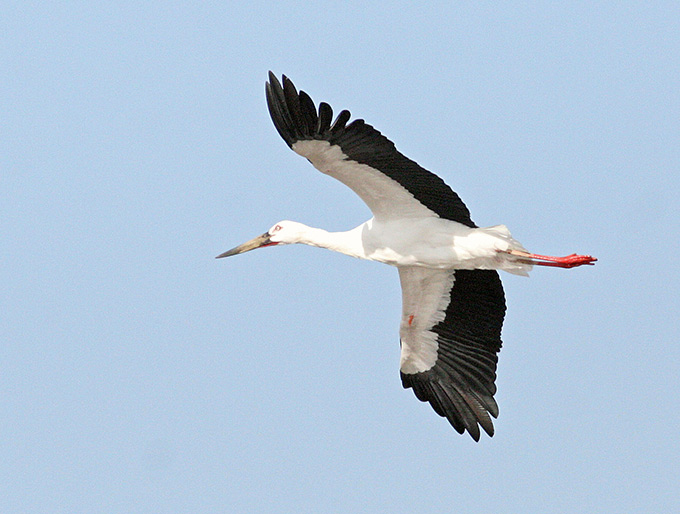

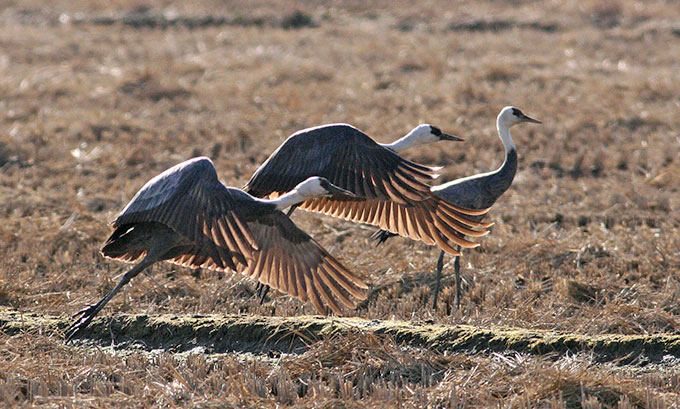


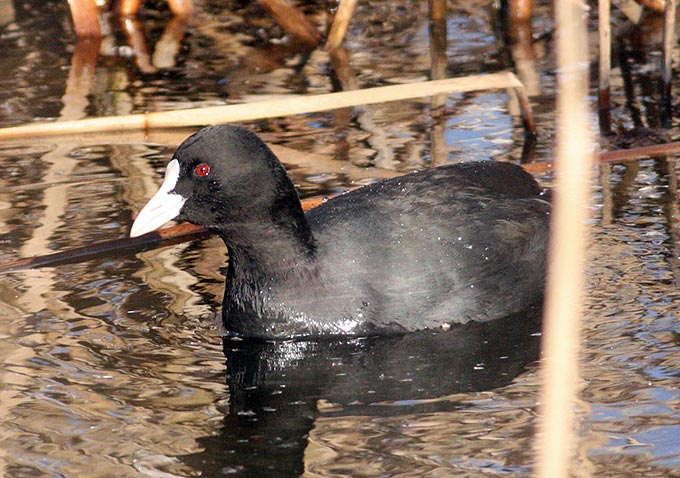

Songdo, December 24
The lagoon area will soon (within 6 months) be shrinking in size due to massive extension of walking/biking roads on both sides starting from the bridge near Dongmak stationn exit #2. Highlights on the lagoon included 45 Common Shelduck and 8 Brambling. On the mudflats I noticed another 50 Common Shelduck. The brackish area held approx. 60 with a handful of Ruddy Shelduck. I tried to stay until the hightide but left because of the depressing deathly views of Mallard, Pintail, and Common Shelduck sadly waiting to die.
Northeast River, December 22
An early morning trip northeast of Seoul in bright (once the sun came up) cold. Scattered Tufted and Spot-billed Ducks, Goldeneyes and Goosanders on the river, but only 2 (distant) Scaly-sided Mergansers in evidence. Other water types were Little Grebe, a Little Egret and a Night Heron. Several Long-billed Plovers chased each other around on the stone-bed; these were joined by 5 Japanese Wagtails and 2 Dippers. A pair of White-tailed Eagles soared past and I also saw a presumed dark-phase Upland Buzzard as well as a Common Buzzard.
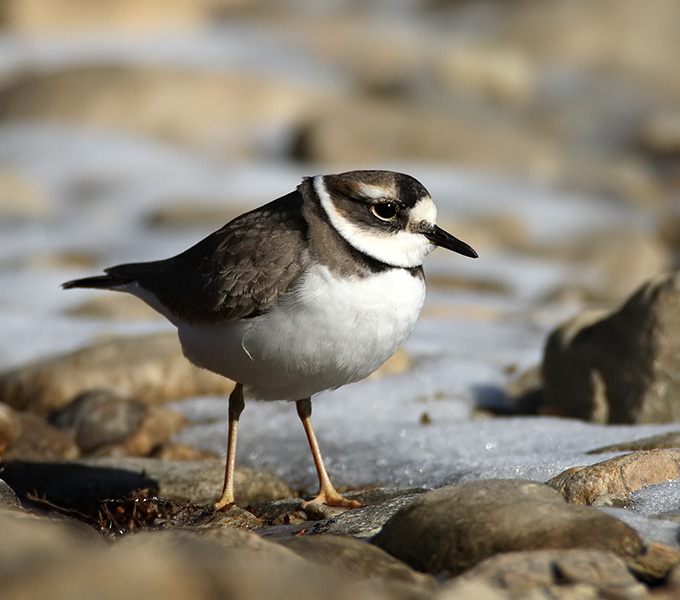
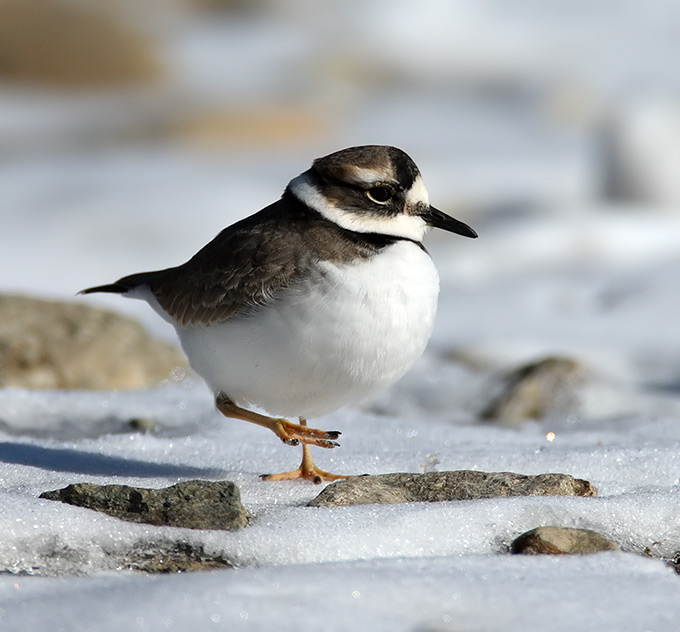




Songdo, December 21
Sunny but cold with a temperature of 4 degrees celsius: soon after a 11.20am high tide at the last remaining mudflat, an outstanding 371 Saunders's Gull were busy hovering, lunging and pouncing on worms as the water receded: this is the highest count since reclamation of this site (and only the second highest count ever here since 640 in Dec. 2001). Around 15% of the birds appeared to be juveniles.
Otherwise, a mix of wintering Vega, Mongolian, Black-headed, Common and 2-3 Heuglins Gull: also 400+ Eurasian Curlew and 3 Ruddy Shelduck.
Botulism continues apace on the brackish area, with scattered corpses and sick wildfowl in various stages of paralysis, including Pintail, Common Shelduck, Spot-billed Duck and Teal.This disease outbreak has not abated since September, and given the ongoing mild weather, this particular shallow waterway could seemingly act as a death-trap for wild birds indefinitely.
Lastly were good views of a hunting female Hen Harrier, which was quite unfazed by keen harassment from the resident Peregrine.
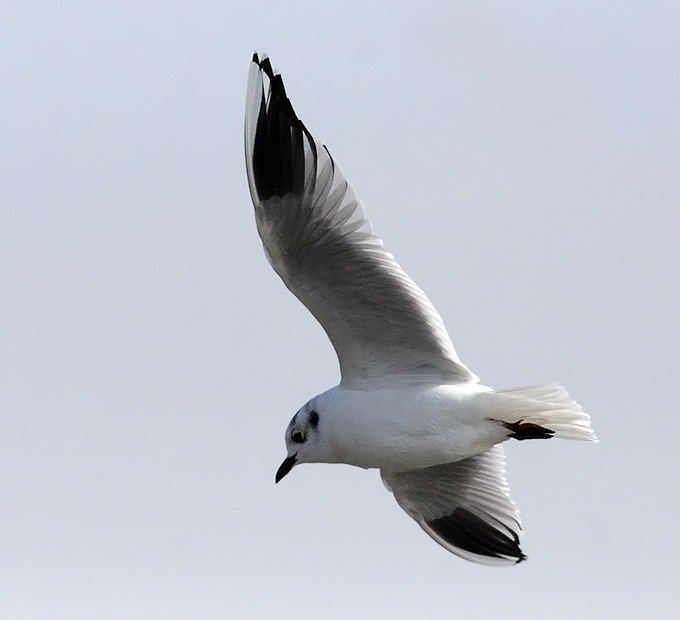
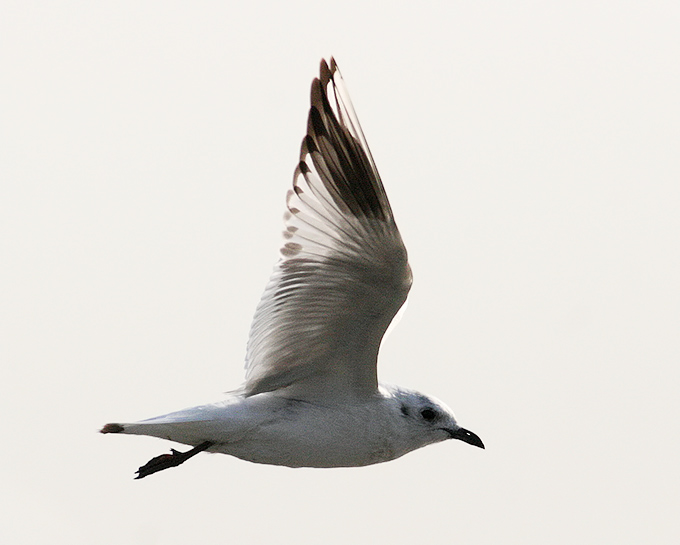


Cheolweon, December 20
Cheolweon under heavy cloud cover and a good deal of fresh snow on the fields and mountains: small overall numbers of birds; highlights were at least 50 Cinereous Vulture (good to see after last month's dearth), one White-tailed Eagle, about 40 White-naped Crane and a dozen Red-crowned Crane, one male Northern Harrier, many Rustic, 2 Meadow and scattered Yellow-throated Buntings, and a few hundred (in separate flocks) White-fronted Geese with smaller numbers of Bean Goose mixed in. Two of the White-fronts had yellow neck-bands. We also saw 2 Water Deer.




Yangyang, Sokcho and Yanggu x Wetlands, December 17
I checked out the birds at Namdae Cheon from the coast to Yangyang on Saturday morning December 13. There were lots of ducks and gulls on the sandbar at the mouth of the river and in the lagoon below Naksandae Bridge. Most abundant were 370+ Mallards and 220+ Spot-billed Ducks. Other ducks included Greater Scaups, Common Mergansers, Gadwalls, Common Goldeneyes and Red-breasted Mergansers. Among the Mallards on the Sandbar was a Black Brant. Other birds in this area included 80+ Black-tailed Gulls, 80+ Slaty-backed Gulls, 2 Glaucous Gulls, Vega Gulls, Great Cormorants and a Peregrine Falcon, the latter resting on the sandbar.
The number of birds upstream from the bridge was relatively low due to the presece of numerous fishermen on the banks and in small boats. There were 160+ Mallards, 60+ Common Teal, 60+ Spotbilled Ducks and 10 Common Mergansers away from the main stream closer to Yangyang.
After lunch the same day I was at Cheongcho Lagoon in Sokcho. Most abundant were 330+ Common (Kamchatka) Gulls and 215+ Mallards. There were 60+ Black-tailed Gulls, 60 Great Crested Grebes, 60 Sanderlings, 30 Grey Herons, 23 Great Cormorants, Slaty-backed Gulls, Vega Gulls, Black-headed Gulls, Spot-billed Ducks, 4 Northern Lapwings, 3 Great Egrets, 2 Little Grebes, 2 Greater Scaups, 2 Little Egrets, a Common Goldeneye, a Black-throated Loon, a Glaucous Gull and a Glaucous winged Gull. I watched one of the Little Egrets catch and eat 3 fish.
I had a free day on Monday December 15 so I had a look at the birds along the river in Yanggu. Ice has begun to form on the larger pools and the new dam so some areas were unavailable to waterbirds. Most birds were concentrated around the weirs and riffles in the river. I was fortunate enough to find a Northern Goshawk resting beside the river. Spot-billed Ducks were most abundant along the river and there were some Mallards, Grey Herons, Common Mergansers and 2 Wigeons. I saw 28 birds species along the river. In the new dam I counted 130+ Spot-billed Ducks and 97 Common Mergansers. On on of the artificial island there were 25 Far Eastern Larks. A flock of 20 Hawfinches were foraging on the ground between the road and the dam, and I saw 28+ Rustic Buntings on the big artificial island shaped like the Korean peninsula. I saw 20 bird species in the dam area. As I was returning home there was a Common Buzzard on one of the power poles beside the road.
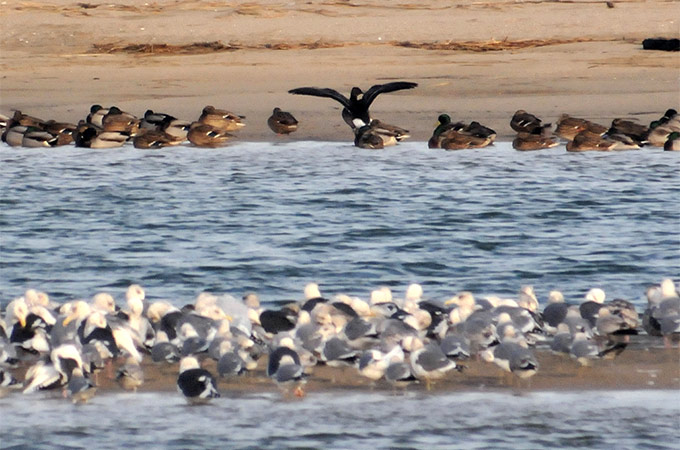


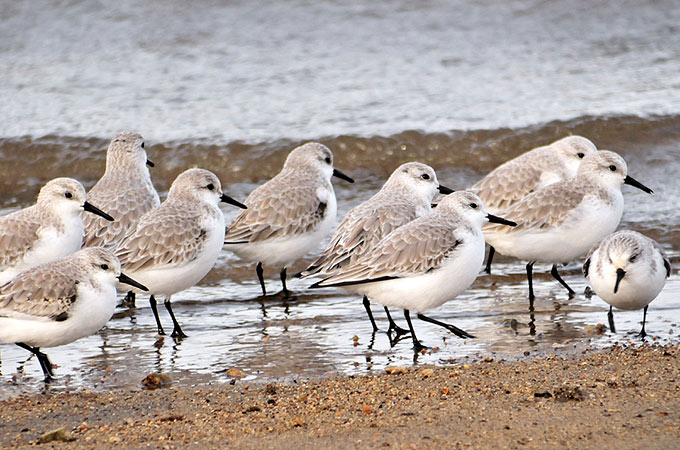
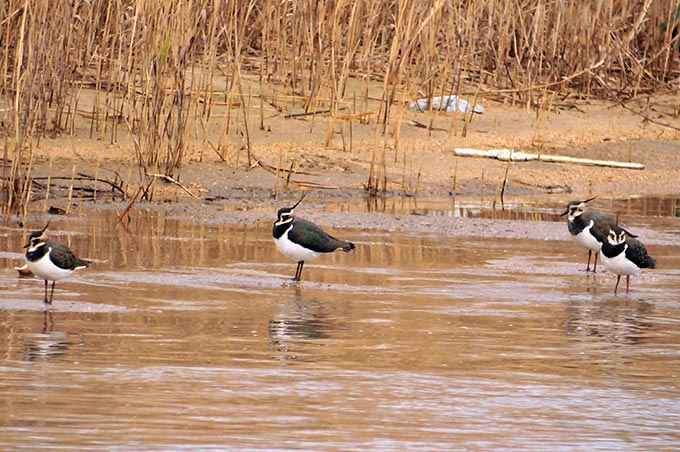


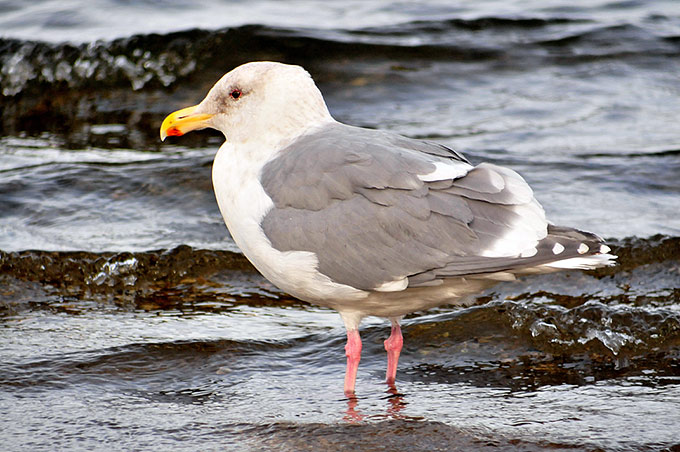




Dokseo, December 14
A brief mid-morning visit to Dokseo only, found 2 Japanese Wagtail, 2 White-tailed Eagle, 2 Black-necked Grebe, 1 Smew and a Common Sandpiper among the commoner species.
Prettiest sight was a feeding flock of 9 Wigeon on the bank. They seem to be remarkably scarce in Gyeonngi province as a whole: this is the only reliable site for them in the Seoul area that I know of.



Mokpo Namhang Urban Wetland & Yongsan barrage, December 14
The morning count at the Mokpo Namhang Urban Wetland at very low tide showed for many species almost the same number as on November 8th and 9th. Biggest increase was seen with 453 Common Shellduck and 516 Common Teal. Spectacular was the flying in of a big flock of 471 Temmerick's Cormorants which could be counted very easily after they made two rounds across the site and then dropped onto the water. After about 30 minutes small groups started heading westward.
The sunny afternoon invited for a walk along the lakeside of the Yongsan barrage and showed 261 Coot. 138 Spot-billed Duck, 39 Mallard 34 Tufted Duck, 3 Common Teal, 2 Great Crested Grebe, 9 Temmerick's Cormorant and 2 distant flocks of about 200-250 gulls each; but both too distant to identify correctly with binoculars.
Gangneung National Arboretum, December 13
A midmorning trip to the National Arboretum found relatively small variety and numbers of birds; highlights were a pair of Solitary Snipe, the usual Eurasian Nuthatches, Varied and Great Tits, and several Hawfinches.
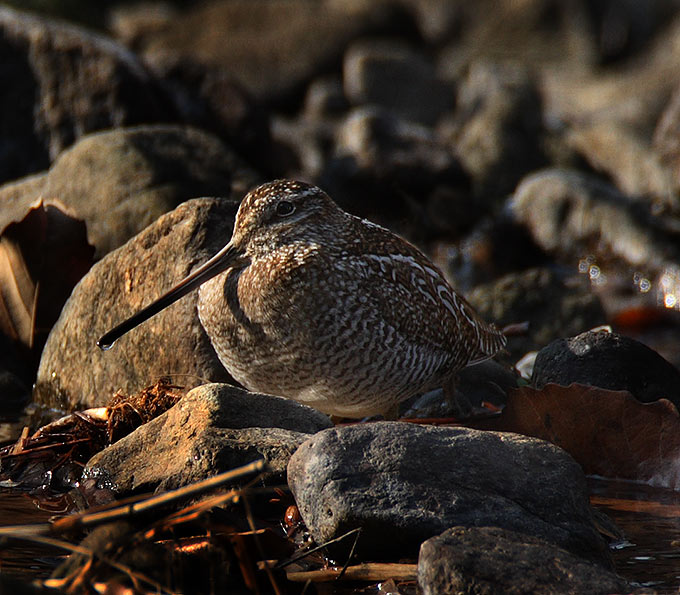
Samyook Dae, December 11
A short visit to Samyook: Varied, Long-tailed, Great and Marsh Tits, a Common Buzzard, about a dozen Bramblings, 3 Hawfinches and 2 Dusky/Naumann's Thrushes, 1 each of Japanese Pygmy and White-backed Woodpeckers.
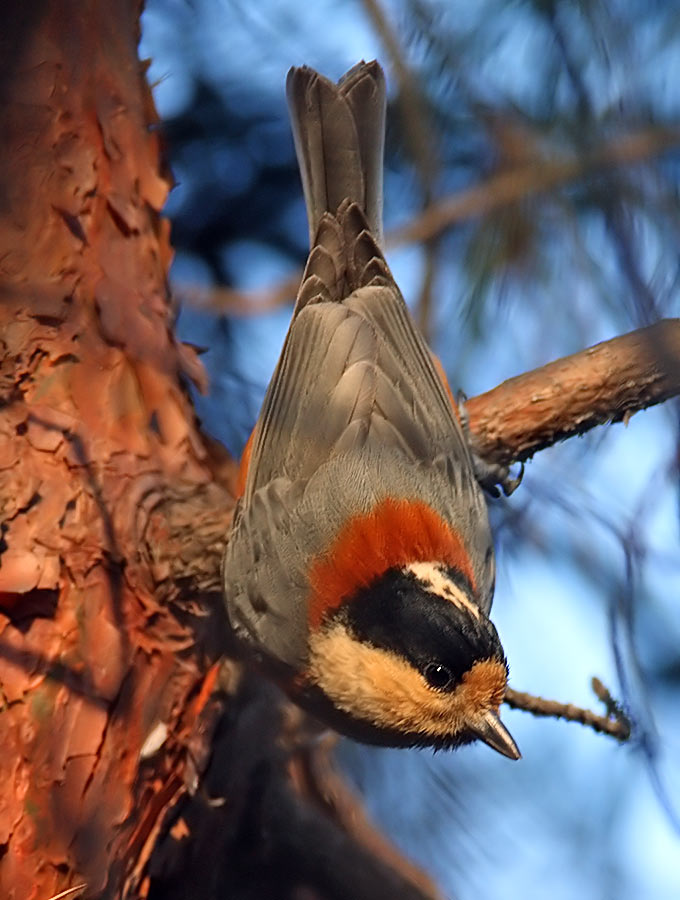



Mokpo Namhang Urban Wetland, December 8 & 9
Both very sunny days showed as most numerous ducks and gulls which were of about 300 Common Shellduck, 60 Gadwall, 20 Falcated Duck, 160 Eurasian Wigeon, 190 Mallard, 320 Spot-billed Duck, 50 Northern Shoveler, 140 Common Teal, 280 Vega Gull and 500 Black-headed Gull. On 9th also 6 Black-tailed Gulls could be identified in the big flock.
The already being infilled location (P3) of the site held about 170 Spot-billed Duck as well as about in total 50 other ducks, about 200 Gulls and as highlight of the 9th 13 Red-breasted Merganser.
On shorebirds 11 Oystercatcher, 4 Long-billed Plover, 3 Common Sandpiper, 86 Dunlin were seen.
Because of the high tide almost all of the 26 Grey Heron and 31 Temminck's Cormorant were roosting on floating platforms. Several times the birds were flushed by either fisher people, passing helicopters and one time by a fast driving truck.
By climbing on a fence which surrounds the reed area of the site 19 Black-crowned Night Heron could be spotted hiding at a pool inside the reed. There also was a male Mallard hybrid pairing with a white domestic duck.
In the adjacent vegetation the common species Treesparrow, Eurasian Magpie, Brown-eared Bulbul, Daurian Redstart and Grey-capped Greenfinch were present in small numbers.
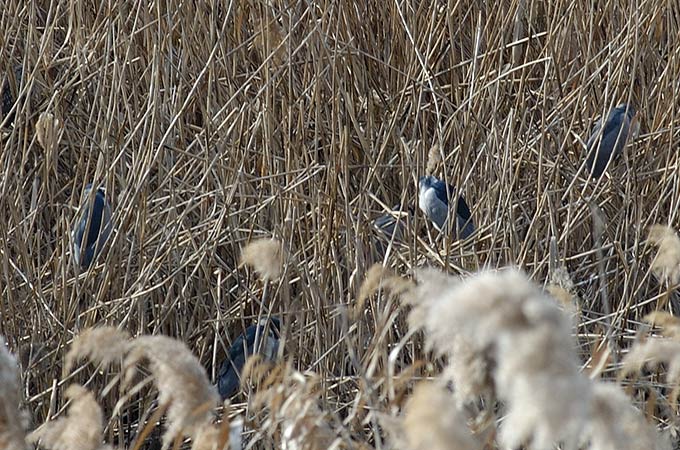
Samyook Dae, December 6
A late-afternoon visit in bitter cold and winds to look for last week's Grey-capped Woodpeckers was unsuccessful for the target bird but was nevertheless good for Japanese Pygmy and Greater Spotted Woodpeckers, an Eurasian Nuthatch, several Hawfinches, a small flock of Bramblings, and Great, Marsh, Long-tailed and Varied Tits.






